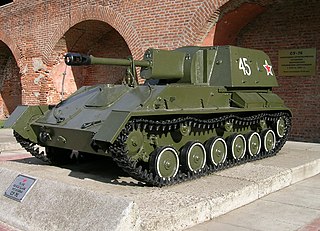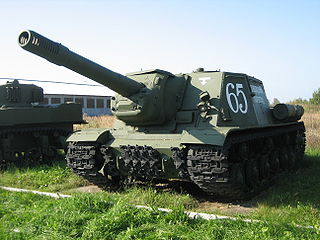
An assault gun is a type of self-propelled artillery which uses an infantry support gun mounted on a motorized chassis, normally an armored fighting vehicle, which are designed to provide direct fire support for infantry attacks, especially against other infantry or fortified positions. Assault guns were pioneered by the Soviet Union and Nazi Germany during the 1930s, initially being self-propelled guns with direct fire in mind, with Germany introducing the first purpose-built assault gun, the Sturmgeschütz III, in 1940.

Self-propelled artillery is artillery equipped with its own propulsion system to move toward its firing position. Within the terminology are the self-propelled gun, self-propelled howitzer, self-propelled mortar, and self-propelled rocket artillery. They are high-mobility vehicles, usually based on continuous tracks carrying either a large field gun, howitzer, mortar, or some form of rocket/missile launcher. They are usually used for long-range indirect bombardment support on the battlefield.

The SU-76 was a Soviet light self-propelled gun used during and after World War II. The SU-76 was based on a lengthened version of the T-70 light tank chassis and armed with the ZIS-3 mod. 1942 76-mm divisional field gun. Developed under the leadership of chief designer S.A. Ginzburg (1900–1943). Its quite simple construction and multipurpose combat role made it the second most produced Soviet armored fighting vehicle of World War II, after the T-34 medium tank.

The SU-122 was a Soviet self-propelled howitzer or assault gun used during World War II. The number "122" in the designation represents the caliber of the main armament, a 122 mm M-30S howitzer. The chassis was that of the T-34.

The SU-85 was a Soviet self-propelled gun used during World War II, based on the chassis of the T-34 medium tank. Earlier Soviet self-propelled guns were meant to serve as either assault guns, such as the SU-122, or as tank destroyers; the SU-85 fell into the latter category. As with the other AFVs in the SU series, the designation "85" refers to the vehicle's main armament, the 85 mm D-5T gun.

The SU-100 is a Soviet tank destroyer armed with the D-10S 100 mm anti-tank gun in a casemate superstructure. It was used extensively during the last year of World War II and saw service for many years afterwards with the armies of Soviet allies around the world.

The SU-152 is a Soviet self-propelled heavy howitzer used during World War II.

The ISU-152 is a Soviet self-propelled gun developed and used during World War II. It was unofficially nicknamed Zveroboy in response to several large German tanks and guns coming into service, including Tigers and Panthers. Since the ISU-152's gun was mounted in a casemate, aiming it was awkward, and had to be done by repositioning the entire vehicle using the tracks. Therefore, it was used as mobile artillery to support more mobile infantry and armor attacks. It continued service into the 1970s and was used in several campaigns and countries.

The T-70 is a light tank used by the Red Army during World War II, replacing both the T-60 scout tank for reconnaissance and the T-50 light infantry tank for infantry support. The T-80 light tank was a more advanced version of the T-70 with a two-man turret—it was produced only in very small numbers when light tank production was abandoned. The T-90 self-propelled anti-aircraft gun was a prototype vehicle with twin machine guns, based on the T-70 chassis.

The ZSU-57-2 Ob'yekt 500 is a Soviet self-propelled anti-aircraft gun (SPAAG), armed with two 57 mm autocannons. 'ZSU' stands for Zenitnaya Samokhodnaya Ustanovka, meaning "anti-aircraft self-propelled mount", '57' stands for the bore of the armament in millimetres and '2' stands for the number of gun barrels. It was the first Soviet mass-produced tracked SPAAG. In the USSR, it had the unofficial nickname Sparka, meaning "twin mount," referring to the twin autocannon with which the vehicle is armed.
Samohodnaya Ustanovka may refer to any of these Soviet casemate self-propelled guns:

AZP S-60 is a Soviet towed, road-transportable, short- to medium-range, single-barrel anti-aircraft gun from the 1950s. The gun was extensively used in Warsaw Pact, Middle Eastern and South-East Asian countries.

The Uralmash-1 (Уралмаш-1) was a Soviet prototype self-propelled gun developed during World War II. It was a turretless, tracked armoured fighting vehicle designed by the Yekaterinburg-based Uralmash design bureau (UZTM) between autumn 1944 and spring 1945. It used the chassis of the T-44 medium tank and was intended to replace the SU-100 which itself had only entered service with the Red Army in late 1944. Two prototypes of the Uralmash-1 with different armament were built in early 1945, one with the 100 mm D-10 tank gun, the other with the 122 mm D-25S tank gun. While mass production was initially recommended, the end of the war with Germany in May 1945 eventually caused the project to be cancelled due to lack of necessity. If the Uralmash-1 had entered service, the 100 mm variant would have been designated SU-101 (СУ-101) while the 122 mm variant would have been designated SU-102 (СУ-102), in accordance with Soviet military nomenclature, where the "SU"-label stood for Samokhodnaya Ustanovka, or self-propelled gun.

ZSU-37 was a Soviet-made, light, self-propelled anti-aircraft gun (SPAAG), developed by the end of 1943 and produced at Works No. 40 in Mytishchi. It was the first Soviet series-produced tracked SPAAG. ZSU stands for Zenitnaya Samokhodnaya Ustanovka, meaning "anti-aircraft self-propelled mount".

The Yugoslav Ground Forces was the ground forces branch of the Yugoslav People's Army (JNA) from 1 March 1945 until 20 May 1992 when the last remaining remnants were merged into the Ground Forces of the new Federal Republic of Yugoslavia, under the threat of sanctions.

The T48 57 mm gun motor carriage was a self-propelled anti-tank gun produced by the Diamond T company in 1943 for the United States. The design incorporated a 57 mm gun M1, a US production of the British Ordnance QF 6 pounder, mounted on an M3 half-track.

The SU-100P is a Soviet experimental 100-mm self-propelled howitzer, and is designed by OKB-3 of the heavy machine construction division of Uralmash. The main designer of the SU-100P is Lev Gorlitsky. The SU-100P was intended to suppress and destroy enemy firing positions, engage enemy armored vehicles, as well as area denial, in addition to conducting counter-battery tasks. It was intended to be the main competitor of the Object 416.

The ZSU-37-2Yenisei was an experimental self-propelled anti-aircraft gun developed in the Soviet Union in the late 1950s. It employed dual 37 mm caliber autocannons with a combined rate of fire of 1048 rounds per minute. After trials the project was halted in 1962 and was not put into serial production.
















